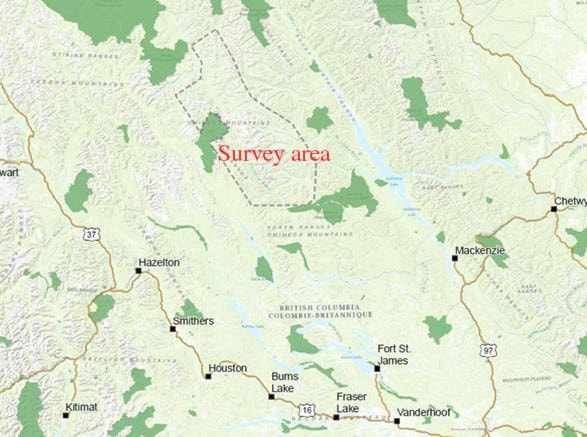Geoscience BC has recently announced its latest aerial survey to identify hidden mineral potential in north central British Columbia.
Called search phase III, the survey will cover a 9,600-square-km area north of Smithers — an area approximately the same size as Haida Gwaii.
Although final details are yet to be confirmed, the area covered is expected to include AuRico Metals’ Kemess Underground Project, a proposed underground copper-gold mine that has recently received its environmental assessment certificate.
The survey will use helicopters fitted with magnetic sensors to build a better understanding of geology in the area. This data will help explorers decide where to focus their mining efforts and could eventually lead to on-the-ground exploration activities that would create jobs and stimulate regional economic activity.
“Experts are certain that there are undiscovered mineral deposits in this area of British Columbia,” said Bruce Madu, Geoscience BC’s vice president of minerals and mining.
“Conducting this research allows more informed decisions to be made; it encourages targeted and responsible development in the future.”
Geoscience BC’s search phase III is a continuation of search phase II, which was conducted in the summer of 2016 in Burns Lake, Smithers, Houston, Vanderhoof and Fraser Lake. Search phase II found indications of copper, silver and molybdenum deposits in the region.
Burns Lake’s Baker Airport was the initial base for search phase II; however, the base was later moved to Smithers due to a runway repaving project at the Burns Lake airport.
According to Geoscience BC, the mining sector in British Columbia has been increasingly positive. On May 16, PwC published its latest annual mining report noting that “the industry is cautiously optimistic.”
Earlier this year, Imperial Metals Corporation became the sole owner of the Huckleberry Mine, an open pit copper mine south of Houston placed on “care and maintenance” in September 2016. According to Huckleberry Mine spokesperson Steve Robertson, the $2-million transaction sends a “strong signal to British Columbians” that Imperial Metals believes strongly in the future potential of the mine.
Search phase III is expected to get underway in July, with results ready in early 2018. Once complete, project information will be made publicly available.
Geoscience BC is an independent, non-profit organization that generates earth science information in collaboration with First Nations, local communities, governments, academia and the resource sector.
